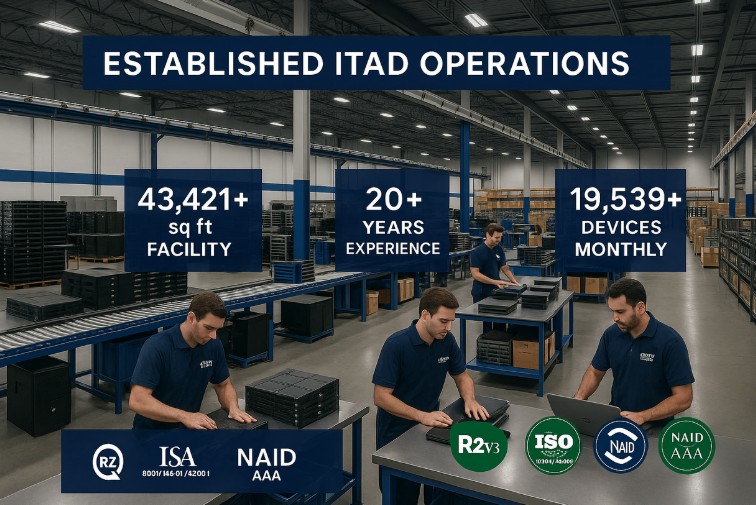Every minute, somewhere in the world, a server powers down for the final time, a laptop reaches the end of its useful life, and a smartphone gets replaced. What happens next determines whether your organization becomes part of the solution to our growing electronic waste crisis or inadvertently contributes to a problem that generates over 62 million tons of e-waste annually. The decisions you make about retiring IT equipment shape your company’s environmental legacy, regulatory compliance status, and data security posture.
Understanding IT Asset Disposition (ITAD)
IT Asset Disposition (ITAD) represents a comprehensive approach to managing the complete IT asset lifecycle, from procurement through final disposal. This strategic process encompasses secure data destruction, environmental compliance, value recovery, and sustainable disposal methods that align with modern business objectives.
The ITAD market demonstrates remarkable growth, with the data center ITAD segment alone expected to expand from $12.42 billion in 2023 to $18.91 billion by 2028, reflecting a compound annual growth rate of 8.8%.
Core components of effective ITAD include:
- Asset identification using advanced tracking systems and QR code scanning
- Data sanitization following NIST SP 800-88 Rev. 1 guidelines
- Value recovery through resale, refurbishment, or component harvesting
- Environmental compliance with local and international e-waste regulations
- Certified destruction for assets beyond recovery potential
The Business Impact of ITAD in Tech Operations
The strategic importance of ITAD in contemporary technology management cannot be overstated. Organizations face mounting pressure from multiple stakeholders to demonstrate responsible stewardship of both digital assets and environmental resources. Non-compliance can result in fines up to €20,000,000 (~$24.5 million) or 4 percent of global turnover under regulations like the General Data Protection Regulation (GDPR).
Key drivers elevating ITAD importance include:
- Regulatory compliance requirements across multiple jurisdictions
- Data security mandates protecting sensitive information throughout asset lifecycles
- Environmental sustainability goals require responsible recycling practices
- Financial optimization through strategic value recovery programs
- Risk mitigation addressing potential data breaches costing organizations an average of $4.45 million in 2023
Approximately 50% of organizations now require sustainability reporting based on IT equipment disposal practices to track environmental impact and support environmental, social, and governance (ESG) initiatives.
Key Concepts of IT Asset Disposition
Secure Data Erasure for Retired IT Assets
Data security represents the cornerstone of effective ITAD implementation. Organizations must ensure complete data sanitization across all storage media before equipment leaves their control. The National Institute of Standards and Technology (NIST) Special Publication 800-88 provides comprehensive guidelines for media sanitization.
Three primary data sanitization methods include:
- Clear: Logical techniques to sanitize data in all user-addressable storage locations
- Purge: Physical or logical techniques that render target data recovery infeasible
- Destroy: Physical destruction of media to render data recovery infeasible
Organizations should verify that their ITAD partners maintain NAID AAA Certification, the most recognized verification of data destruction qualifications worldwide.
Compliance With Regulatory Standards
Regulatory compliance in ITAD encompasses multiple frameworks spanning data protection, environmental stewardship, and industry-specific requirements.
Primary regulatory considerations include:
- Data protection regulations such as GDPR, HIPAA, and CCPA require secure data handling
- Environmental regulations, including the Resource Conservation and Recovery Act (RCRA), govern hazardous waste management
- Industry standards like R2 Responsible Recycling Standard
- International frameworks addressing the cross-border movement of electronic waste
Best Practices for Effective ITAD
Disposition Planning for IT Asset Lifecycle Management
Strategic disposition planning forms the foundation of successful ITAD implementation. Organizations must develop comprehensive policies addressing asset identification, data classification, disposal timelines, and vendor selection criteria.
Essential planning elements include:
- Asset inventory systems provide real-time visibility into equipment status
- Data classification frameworks identifying sensitive information requiring enhanced protection
- Disposal scheduling, optimizing timing to maximize value recovery potential
- Vendor qualification processes ensure ITAD partners meet security requirements
- Cost-benefit analysis evaluating disposal options against organizational objectives
Asset Tracking Techniques
Modern asset tracking employs advanced technologies to maintain comprehensive visibility throughout the ITAD process. Organizations utilize various tracking methodologies to ensure accountability and support compliance requirements.
Advanced tracking technologies include:
- QR code scanning to enable rapid asset identification and status updates
- RFID technology that provides automated tracking capabilities
- Blockchain technology for immutable audit trails
- Cloud-based asset management systems offering real-time visibility
- Artificial intelligence to optimize disposal decisions based on historical data
Sustainable Disposal Methods
Sustainable disposal methods prioritize environmental stewardship while maximizing value recovery potential. The concept of a circular economy emphasizes keeping materials in productive use for as long as possible.
Sustainable disposal hierarchy includes:
- Reuse: Direct redeployment of functional equipment within the organization
- Refurbishment: Restoration of equipment for continued use by other organizations
- Component harvesting: Recovery of valuable components for spare parts
- Material recovery: Extraction of precious metals and other valuable materials
- Responsible recycling: Environmentally sound processing of remaining materials
Benefits of Implementing ITAD Policies
Environmental Benefits
Electronic waste represents the fastest-growing waste stream globally, with only 22.3% of the 62 million tons of e-waste generated globally in 2022 receiving proper recycling treatment.
Key environmental benefits include:
- Waste reduction through extended asset lifecycles and responsible disposal
- Resource conservation by recovering valuable materials for reuse
- Carbon footprint reduction through optimized transportation and processing
- Pollution prevention by ensuring proper handling of hazardous materials
- Ecosystem protection through the prevention of toxic substance release
Financial Advantages
Strategic ITAD implementation delivers substantial financial advantages through multiple value-creation mechanisms.
Primary financial benefits include:
- Value recovery through equipment resale and refurbishment programs
- Cost avoidance by preventing regulatory fines and data breach incidents
- Tax benefits through proper depreciation reporting and charitable donations
- Operational efficiency gains from streamlined disposal processes
- Risk mitigation that reduces potential financial exposure from compliance failures
The North American ITAD market is projected to reach $10.15 billion by 2029 with a growth rate of 6.8%.
Selecting Certified Disposal Partners
Choosing appropriate ITAD partners represents a critical decision affecting data security, regulatory compliance, and environmental stewardship outcomes.
Essential partner qualifications include:
- Industry certifications such as R2v3,, ISO 14001, and NAID AAA
- Security clearances appropriate for handling sensitive data
- Insurance coverage protecting against potential data breaches
- Audit capabilities providing transparent reporting and compliance verification
- Geographic coverage supporting multi-location disposal requirements
OEM Source exemplifies the comprehensive certification approach required for enterprise ITAD partnerships. As an R2v3 and NAID-certified leader in IT asset disposition, OEM Source maintains the rigorous standards necessary for handling sensitive data while supporting organizational sustainability goals.
Technological Advancements in ITAD
Technological innovation continues transforming ITAD practices, introducing new capabilities for asset tracking, data destruction, and value recovery.
Emerging technologies include:
- Artificial intelligence optimizing disposal decisions and value recovery strategies
- Internet of Things sensors providing real-time asset monitoring
- Advanced data destruction techniques ensure complete data sanitization
- Automated sorting systems are improving recycling efficiency
- Predictive analytics forecasting optimal disposal timing and methods
Future Trends in IT Asset Disposition
The ITAD industry continues evolving in response to technological advancement, regulatory development, and changing stakeholder expectations.
Key trends shaping ITAD’s future include:
- Increased automation is reducing manual processes and improving efficiency
- Enhanced transparency through blockchain and other verification technologies
- Expanded regulations addressing emerging environmental and security concerns
- Circular economy integration supporting sustainable business models
- Stakeholder engagement requires comprehensive sustainability reporting
OEM Source’s data destruction services exemplify the integration of security and sustainability objectives, providing certified data destruction while supporting environmental compliance through responsible recycling practices.
Optimizing Your IT Asset Disposition Strategy for Maximum Impact
As organizations navigate increasingly complex regulatory requirements and sustainability goals, implementing a thoughtful, secure ITAD strategy is no longer optional—it’s essential. By aligning data security, environmental responsibility, and financial optimization, modern IT asset disposition helps businesses reduce risk while unlocking long-term value.
Ready to optimize your IT Asset Disposition strategy? Contact OEM Source today to learn how our certified ITAD services can help maximize value while ensuring data security and environmental compliance.
Frequently Asked Questions
What is the IT asset disposition process?
The IT asset disposition (ITAD) process involves the systematic retirement, sanitization, and disposal of IT equipment at the end of its useful life. This includes data destruction following NIST guidelines, value recovery through resale or recycling, environmental compliance verification, and final disposal through certified ITAD partners.
What is the asset disposition process?
Asset disposition refers to the broader lifecycle management of any organizational asset—not just IT. It includes decommissioning, data security protocols, value optimization, regulatory compliance verification, and environmentally responsible disposal methods.
What is the difference between IT asset disposal and disposition?
IT asset disposal refers specifically to the physical act of discarding or destroying equipment. In contrast, IT asset disposition is a comprehensive, strategic process that includes planning, secure data handling, value recovery, and final disposal. Disposition ensures maximum return on investment and regulatory adherence.
How do you handle the disposal of IT assets?
Proper IT asset disposal requires working with certified ITAD providers, like OEM Source, who follow strict protocols for secure data destruction, chain of custody tracking, environmental compliance, and value recovery. This includes detailed asset inventories, data classification, transportation controls, and certificates of destruction.
Why is certified IT asset disposition important?
Certified ITAD ensures your organization meets data privacy laws (like HIPAA or GDPR), avoids costly fines, and supports sustainability goals. Providers with certifications such as R2v3 and NAID AAA demonstrate verified compliance, helping businesses protect sensitive data and minimize environmental impact.





